Lechuguilla Cave
Useful Information
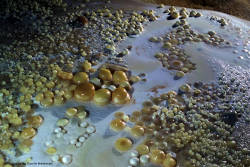
 Cave Pearls, Lechuguilla Cave, NM, U.S.A. Public Domain.
Cave Pearls, Lechuguilla Cave, NM, U.S.A. Public Domain.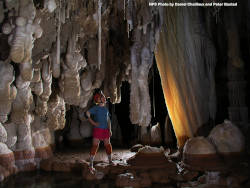
 Pendulite, Lechuguilla Cave, NM, U.S.A. Public Domain.
Pendulite, Lechuguilla Cave, NM, U.S.A. Public Domain.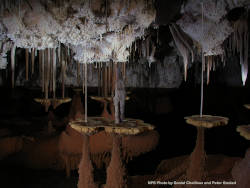
| Location: |
Carlsbad Caverns NP, NM.
10 km off Highway 62/180. (32.190656, -104.503317) |
| Open: | Closed! |
| Fee: | Closed! |
| Classification: |
 Karst Cave Karst Cave
 Hypogene Caves Hypogene Caves
|
| Light: | bring torch |
| Dimension: | L=244,790 m, VR=484 m, Ar=3,763,024 m², V=62,037,861 m³, A=1,414 m asl. [2022] |
| Guided tours: | n/a |
| Photography: | allowed |
| Accessibility: | no |
| Bibliography: |
Urs Widmer (1998):
Lechuguilla - Jewel of the Underground,
Speleo Projects; Revised 2nd Edition (January 1, 1998), 164 pp, ISBN-10: 3908495016, ISBN-13: 978-3908495017.
Stephen Reames,Lawrence Fish, Paul Burger, Patricia Kambesis (1999): Deep Secrets, The Discovery and Exploration of Lechuguilla Cave, Cave Books, ISBN: 0939748282 (Paperback), 0939748185 (Hardcover)  Hardcover at Amazon.com | Hardcover at Amazon.com |
 Paperback at Amazon.com Paperback at Amazon.com
National Geographic’s Mysteries Underground, National Geographic Video (VHS), 1997. buy at Amazon.com Max Wisshak, Hazel A. Barton (eds.) (2022): Lechuguilla Cave: Discoveries in a Hidden Splendor speleo-photo editions, Friedeburg, 240 p., ISBN 978-3-9821714-2-5. online |
| Address: |
Carlsbad Caverns National Park, 3225 National Parks Hwy., Carlsbad, NM 88220, Tel: +1-505-785-2232.
E-mail: Tour reservations, Tel: 1-800-967-2283, international Tel: +1-301-722-1257. |
| As far as we know this information was accurate when it was published (see years in brackets), but may have changed since then. Please check rates and details directly with the companies in question if you need more recent info. |
|
History
| 1914 | mining claim for guano filed, mined for a year, known as Misery Hole. |
| 1950s | cavers hear wind roaring up from the rubble-choked floor of the cave. |
| 1952 | entrance surveyed by Colorado Grotto cavers. |
| 1984 | start of digging by a group of Colorado Grotto cavers with permission from the National Park Service. |
| 26-MAY-1986 | entrance to cave below discovered. |
| 1987 | first documentary of the cave filmed by the Denver Museum of Nature and Science, titled Lechuguilla Cave: The Hidden Giant. |
| 1992 | National Geographic Society program titled Mysteries Underground filmed. |
| 2007 | featured in the BBC documentary series Planet Earth, fourth episode titled Caves. |
| 2016 | Episode Genesis of the National Geographic series One Strange Rock (season 1, episode 4) filmed. |
Description
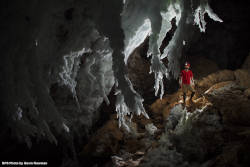
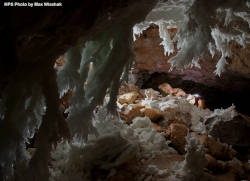
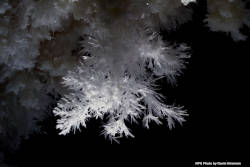
 Aragonite, Lechuguilla Cave, NM, U.S.A. Public Domain.
Aragonite, Lechuguilla Cave, NM, U.S.A. Public Domain.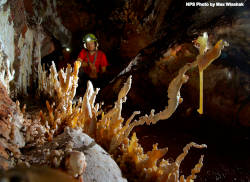
Lechuguilla Cave is the sixth-deepest and the fourth-longest limestone cave in the United States [2022]. It is named after the agave Agave lechuguilla, a member of the family Agavaceae, that grows all around the cave entrance.
Lechuguilla Cave is called the most beautiful cave of the World, as it is full of speleothems and troglobionts found nowhere else in the world. And as it is extremely fragile it is not possible to visit this cave, except for a small contingent of researchers. The National Park authorities try to keep it in an undisturbed state. It is necessary to contact the Carlsbad Caverns National Park and explain the reason of the visit and provide credentials for your caving skills. Speleologists also have to prove that they are able and willing to take care of the cave. The cave is hot, dry, technically demanding, and strict protection rules make caving here quite strenuous. For a few years, less than ten expeditions per year were allowed. After the theft of a very famous cave pearl, the cave was closed completely for several years!
The recent exploration and scientific discoveries in Lechuguilla Cave, and other caves in the park, hold immense potential for scientific research. But still there is a drawback: the caves are extremely fragile, as especially the selenite formations may be destroyed even by slightest changes in humidity. In some cases it was reported that a group of caver breathing in a huge hall for some time caused the collapse of fragile gypsum chandeliers.
Lechuguilla Cave was formed by processes, which differ from regular karstification. Limestone requires an agent, an acid, so water is able to directly dissolve the rock. Normally there is a small amount of carbon dioxide (CO2) in the water which makes it carbonic acid, which is very weak, but still dissolves big cave system over long period of time. But here in Lechuguilla Cave, the chemistry was different, there is a huge amount of cave minerals which contain sulfur. Such minerals are formed by chemical reactions with sulfuric acid. A second strange thing was the enormous cave system, hundreds of kilometers of huge passages and chambers, with actually little connection to the surface drainage system. Karst caves are generally the conduits in a huge drainage system, but Lechuguilla Cave is covered by limestone with almost no caves and there is no obvious drainage system.
The solution to these puzzles was a new theory of cave formation, which differs from the classical theories but seems to be relevant for many other caves as well. One basic thing is dissolution by sulfuric acid which was formed by the chemical decomposition of an oilfield below. The oil contains hydrogen sulfide which reacts with groundwater. The water body was filled with sulfuric acid, which dissolves huge amounts of limestone, much more than carbonic acid would. The water exchange is slow, so the solution stays underground for a long time which chemical reactions go on and other chemical substances, combination of calcite and sulfur are formed. They start to redeposit, mostly in form of minerals. This explains the enormous amount of sulfur based minerals like gypsum and other rare minerals like hydromagnesite.
This process of speleogenesis (cave formation) requires much less water than classical karstification, which also fits the measurements. It was a completely new theory and caused a sort of creative big bang among cave scientists worldwide. Now there was no need any more to have a source of dissolvents from the surface. During the last 30 years many new effects and theories were published in scientific literature, which may be called hypogene karstification, solution by chemical reaction of substances which are already underground and are transported by the groundwater body. In other words, the main driver of cave formation at Lechuguilla Cave is hypogene sulfuric acid speleogenesis. It is located in 265 to 259 million years old Permian limestone which are locally called Capitan Limestone, Seven Rivers Formation, and Yates Formation.
Another impressive field of scientific research was strongly connected to this new research. There were arguments by old school mineralogists which could not explain the chemical reactions with normal chemistry. There were simply no suitable reactions, although the elements were all there. A new theory postulated a biologic influence by microbes which live underground in fissures of the rock. One problem was, that those microbes were at or below the resolution of regular REMs. But fortunately at the same time the technology became better, and it was now possible to see those extremophiles.
Extremophiles are bacteria which love extreme habitats. They process various substances to gain energy, for example oxidize sulfur or process it in other ways which produces energy. The chemistry of the microbes produces the substances which create the cave (sulfuric acid) and form the minerals (gypsum, hydromagnesite asf.). Many scientists concentrate on the study of those bacteria, as they hope they developed efficient methods of killing other bacteria, which could qualify as antibiotics. The overall use of this research for pharmacy could be enormous, as much as the revenues.
As a matter of fact the Lechuguilla Cave is not only a beautiful treasure of nature it also started and influenced scientific research in various areas. Now theories of speleogenesis were developed, and the number of papers published on scientific work in the cave is enormous. There are also two notable coffee table books about the cave. The first is Lechuguilla - Jewel of the Underground by the famous Swiss cave photographer Urs Widmer was published in the 1990s in numerous languages. It is the foundation of the fame of this cave. Recently a new book was published by the German cave photographer Max Wisshak and speleobiologist Hazel A. Barton named Discoveries in a Hidden Splendor. Max Wisshak also provided many of the official pictures on the NPS website and on this page.
- See also
 Crater Names on Asteroid Ida
Crater Names on Asteroid Ida Search DuckDuckGo for "Lechuguilla Cave"
Search DuckDuckGo for "Lechuguilla Cave" Google Earth Placemark
Google Earth Placemark Lechuguilla Cave - Wikipedia (visited: 28-APR-2013)
Lechuguilla Cave - Wikipedia (visited: 28-APR-2013) Lechuguilla Cave - Carlsbad Caverns National Park (visited: 28-APR-2013)
Lechuguilla Cave - Carlsbad Caverns National Park (visited: 28-APR-2013) Lechuguilla Cave (visited: 17-NOV-2022)
Lechuguilla Cave (visited: 17-NOV-2022) Take a virtual tour of the Deepest Cave in the US (visited: 28-APR-2013)
Take a virtual tour of the Deepest Cave in the US (visited: 28-APR-2013) Lechuguilla Photo Map (visited: 28-APR-2013)
Lechuguilla Photo Map (visited: 28-APR-2013)
 Index
Index Topics
Topics Hierarchical
Hierarchical Countries
Countries Maps
Maps